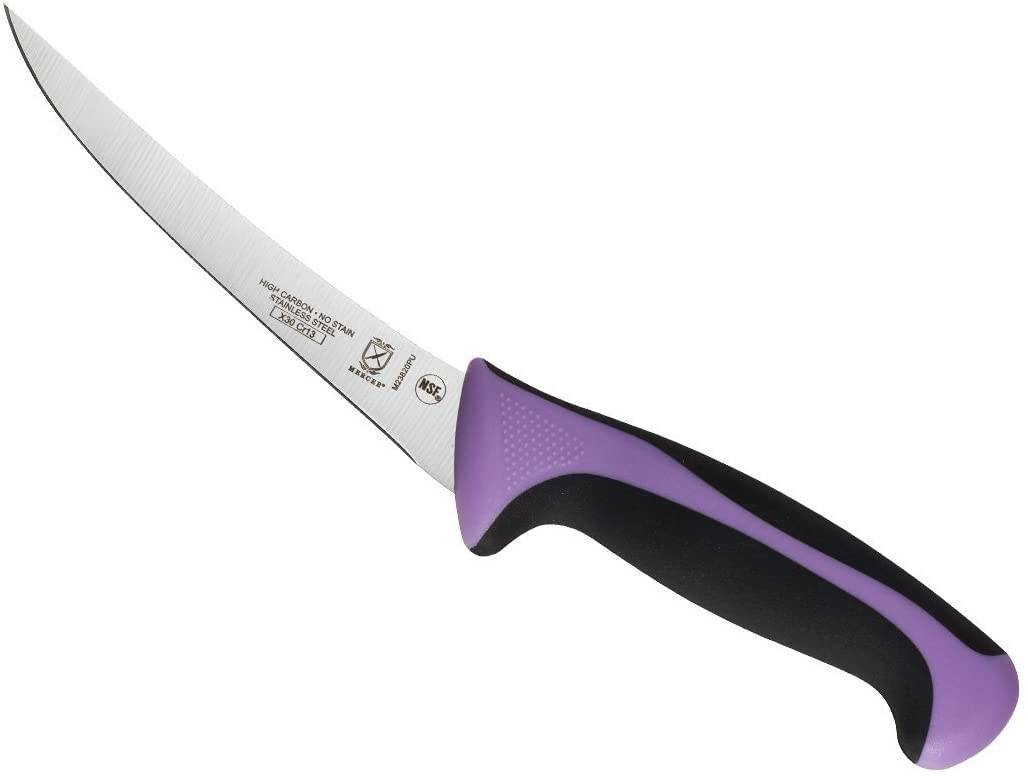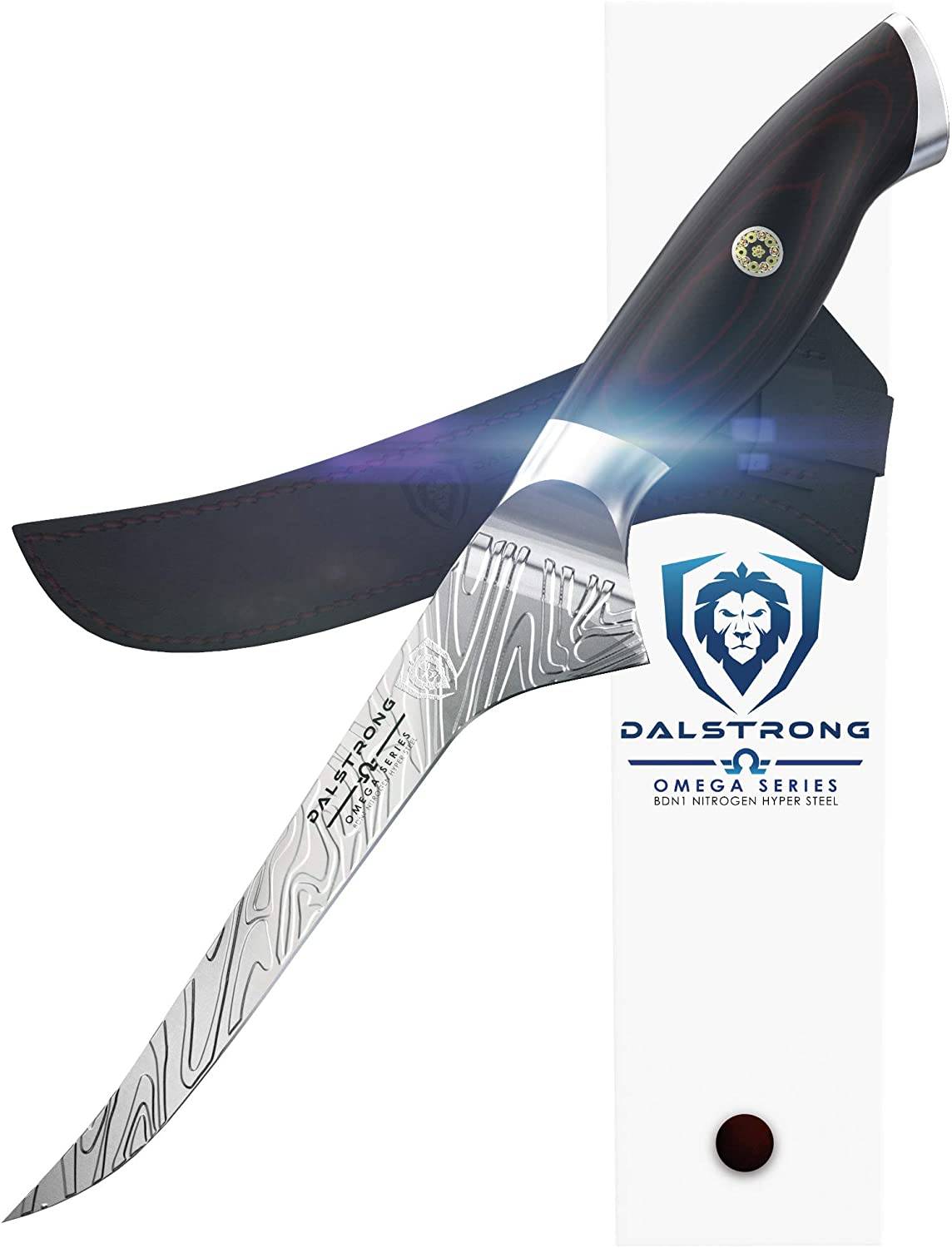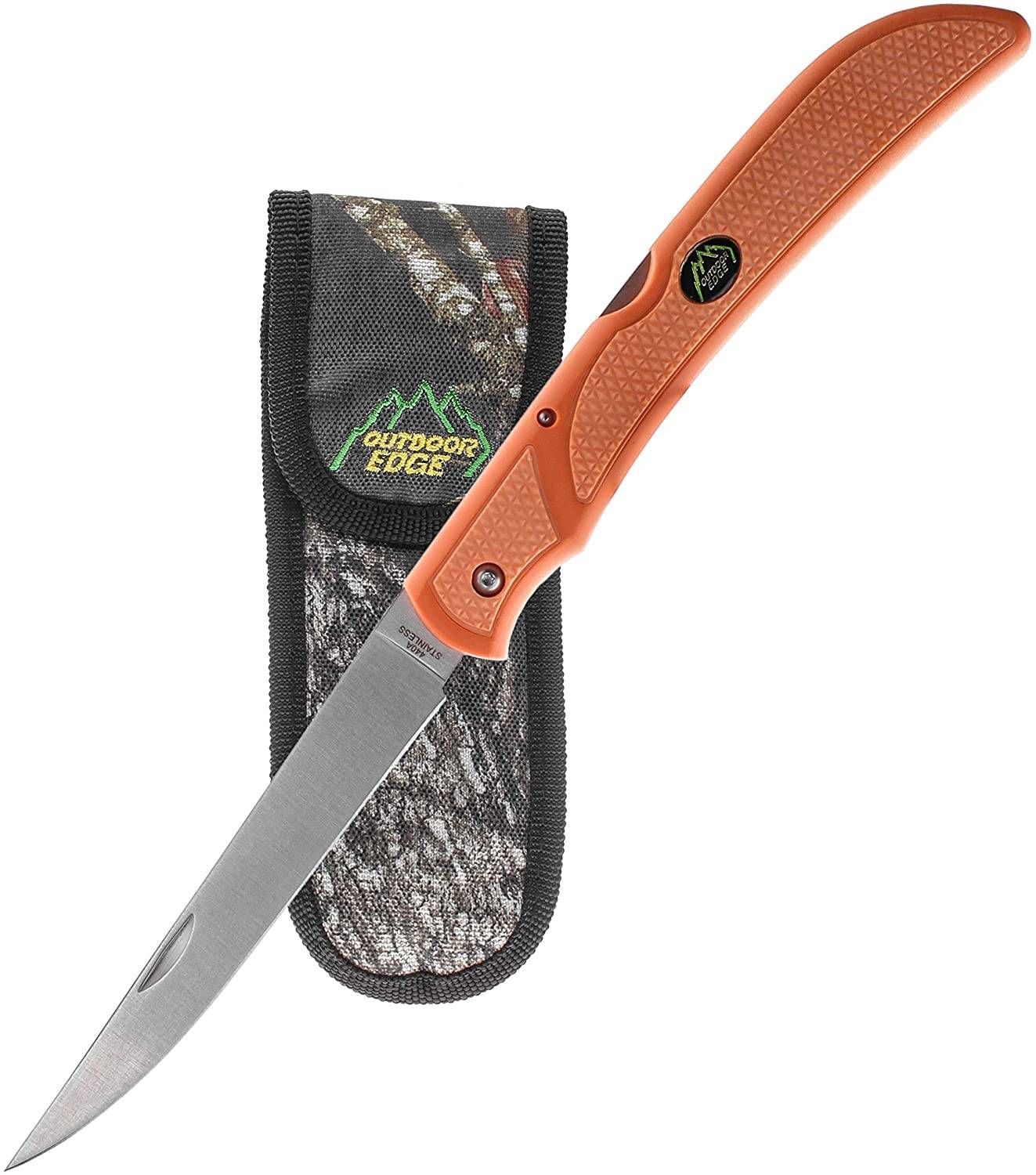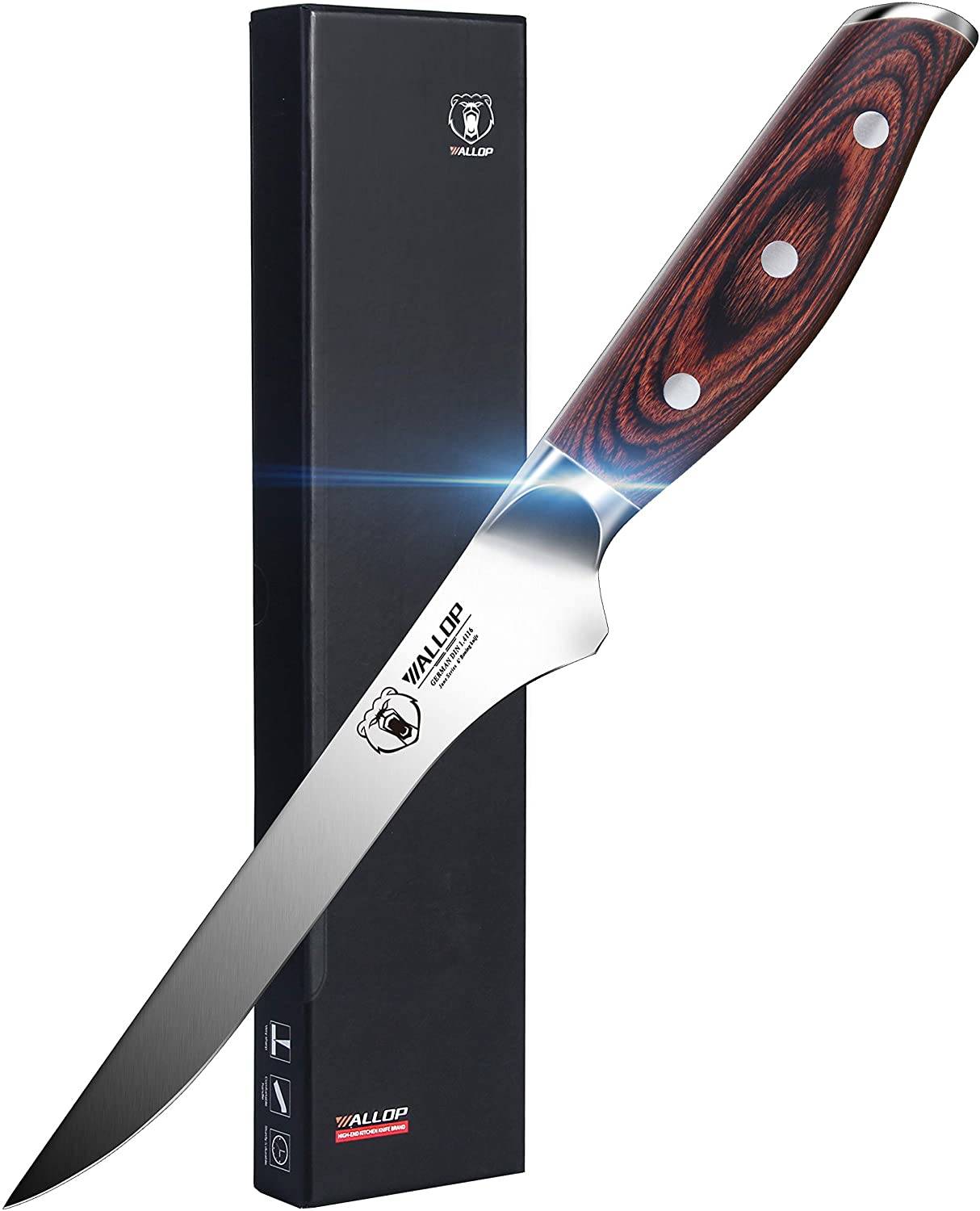Best Boning Knife
They say using a dull knife is often more dangerous than using a sharp one. That’s because we put more pressure on the knife when using a dull blade to cut through something. This increases the chances of the knife slipping and cutting your hand instead. By comparison, a sharp knife “bites” the surface more readily, making a smooth, clean cut.
This principle is especially true when it comes to boning knives used to debone or filet meat, poultry or fish. Not only must the knife be sharp, it must also be the right type of utensil for the job.
For example, one important aspect of a knife is its flexibility. If a more flexible blade that works better to filet fish or debone a chicken goes into a thicker cut of meat, the blade can bend or break. Alternatively, if a stiff blade is used on fish, it will be more difficult to remove the bones.
We narrow down the four best deboning knives you can buy online. Read on to find the one that works for you.
Top Pick Best Budget: Mercer Culinary Millennia 6-Inch Curved Boning Knife
You’re looking for a sharp boning knife to add to your kitchen arsenal, but you’re on a budget. But that doesn’t mean you want something that is cheaply made or won’t work well. If you are looking for a high-quality, affordable boning knife, then consider this model.
We recommend the Mercer Culinary Millennia 6-Inch Curved Boning Knife for all of your de-boning needs. Crafted from high-quality, non-staining, high-carbon Japanese steel, this precision-made knife resists rust, corrosion and discoloration, and is certified by the NSF, meeting their stringent standards for safety, quality and performance.
This high-performance knife should be hand-washed and not put into the dishwasher in order to maintain the integrity of the handle. For best results, store the knife in a cutlery block or sheath to preserve the cutting edge and prevent injuries.
Backed by a one-year limited warranty.
Pros:
- Affordable
- Made from high-carbon Japanese steel
- Backed by a limited one-year warranty
Cons:
- Handle only has partial tang
Top Pick Best Versatile: DALSTRONG Boning Knife
You consider yourself a kitchen ninja, chopping, slicing, baking and brewing. To you, a good knife is like having a best friend: dependable and able to help get any task done well. If you are looking for a top-quality, sharp and versatile boning knife that will not let you down, then this is the model for you.
For precise butchery work including de-boning, fileting, skinning, trimming and butterflying meat, chicken and fish, we recommend the DALSTRONG – Boning Knife – 6” – Omega Series – American Forged BD1N-VX- Hyper Steel – w/Sheath.
The narrow blade on this knife is shaped to effortlessly sail along the contours of bones, slicing flesh away with ease. The “LiquidMetal” pattern on the blade reduces drag and increases efficiency, allowing you to glide through sinew, fat and muscle to provide a perfectly clean separation.
More about the blade, which is made from ultra-premium American forged BD1N-V hyper steel. Special detail and care has gone in to its construction – added vacuum heat-treatment to 63HRC make for a superior performance with a very sharp edge. The blade is then finished to 8-12° per side using the traditional three-step Honbazuke method. The addition of nitrogen increases the blade’s hardness, flexibility, and toughness. You know this knife will last a lifetime.
Equipped with a full-tang, non-slip-grip handle that’s made from woven fiberglass to resist heat, cold and moisture, you know this is the only boning knife you will ever need. Oh, and did we mention it comes with a black PU leather sheath with button clip and distinctive red-stitching to protect the blade – and prevent accidents when not in use.
Pros:
- Versatile, good for meat, poultry and fish
- Full-tang, non-slip-grip handle
- Top quality, sharp blade
- PU leather sheath with button clip included
Cons:
- More expensive than other models
Top Pick Best Folding Deboning Knife: Outdoor Edge Fish & Bone
You do a lot of cooking at home, but you also like to spend a lot of time outdoors, camping, hunting and fishing. Preparing your catch to cook and eat the same day is part of your outdoor experience and to do that, you need a good deboning knife. In the past, you’ve equipped yourself with different knives to suit each purpose but that’s proven to be bulky and inefficient. In an effort to scale down, you now want something you can take with you while you’re on the hunt and walking on trails.
We recommend the Outdoor Edge Fish & Bone – folding fillet Knife with 5.0” 44A Stainless Steel Blade for Fish and Processing Big Game – Pocket Clip (Orange) for all your hunting and fishing food prep needs.
Slim and lightweight, this folding boning knife fits easily into your pocket, backpack, tackle box or fly fishing bag. The 5-inch 440A stainless steel blade is razor sharp and when fully extended, the knife measures 11.3 inches.
The double-molded Zytel handle features rubberized, non-slip TPR inserts for a secure, non-slip grip, and the bright orange color is hard to miss in the wild, a real bonus if you drop your knife or put it down for a few minutes. This quality knife is perfect for all your outdoor needs – filleting trout, crappie, bass, catfish, walleye, perch, salmon, and rock fish; or processing wild game including waterfowl, upland birds and big game.
It also comes with a pocket clip, Mossy Oak nylon belt sheath. Weighing only 3.5 ounces, you’ll never even know it’s there.
Pros:
- Versatile knife for all uses for fishing and hunting
- Folds for convenience
- Includes a pocket clip nylon belt sheath for portability and safety
- Bright orange handle easy to see in the woods
Cons:
- Does not come with a warranty
Top Pick Best Flexible Boning Knife: WALLOP Boning Knife
You’re just starting out on your culinary journey and are determined to bring out your inner chef. That means equipping your kitchen with the right tools and utensils to help you get the job done right. That includes using the right knife for the task. If you’re looking for a high quality flexible-blade deboning knife, then this may be the product for you.
We recommend the WALLOP Boning Knife – 6” Flexible fillet Knives – German 1.4116 High Carbon Stainless Steel Kitchen Knife for deboning Meat Poultry Chicken fish – full Tang Pakkawood Handle with Gift Box to help your inner chef shine.
This six-inch boning knife is made from high quality German 1.4116 High Carbon Stainless Steel for added rust resistance. A vacuum heat-treatment and nitrogen cool treatment to 56+ HRC gives the blade strength, flexibility, and durability.
Razor sharp, you won’t be disappointed in the performance of this knife, which was hand-sharpened using the traditional three-step Honbazuke method at staggering 14-16° double-bevel blades. The ergonomic wooden full-tang handle with triple riveted and forged bolster not only looks great, it also provides balanced knife handling for efficient cutting and a non-slip, comfortable grip.
To top it off, this amazing deboning knife comes with a 100 percent satisfaction or money back guarantee. And did we mention that it comes in a premium gift box? It would make a great gift for a friend or family member who can appreciate the merits of a fine kitchen tool.
Pros:
- Full-tang handle
- Made from high quality German 1.4116 High Carbon Stainless Steel
- Money-back satisfaction guarantee
Con:
- More expensive than other models
Things to look out for:
Consider these things when looking for a deboning knife so you will choose one that best suits your needs:
Type
The flexibility of a knife is an important factor to consider when looking for the right deboning knife because if a flexible knife goes into a thicker cut of meat, it will often break or bend. However, if a stiff knife is used on fish, you’ll have a much harder time removing all of the bones. So the boning knife you choose can be stiff or flexible.
A stiff knife is used for thicker cuts, while a flexible knife, which is often smaller in size, provides greater flexibility and control. If you want a deboning knife mainly to remove bones from fish or poultry, then use a flexible knife. Otherwise, your best bet is a stiff knife.
Size
The average blade of a deboning knife will be between five and 6.5 inches. The smaller the blade, the more flexibility you’ll have. Of course, there is no one-size-fits-all option when it comes to deboning knives, but as a general rule, choose a smaller blade if you’re removing bone from delicate cuts.
For that reason, some people will have two deboning knives, one with a smaller blade and one with a larger one. Occasionally you can find a deboning knife that is bigger, between seven and nine inches, but these are often used for really large cuts of meat.
A few deboning knives have blades in the size range of 7 – 9 inches, but these are more of a specialty item that would be needed for extremely large cuts of meat, and are often used by butchers to make their job easier.
Handle
The handle on the knife is pretty important, as you put all of your force through the handle of a knife to do the cutting. There are a variety of handle types available, from wood to hard plastic, and it’s okay to choose one that looks the best to you.
Synthetic materials, such as Polypropylene, have coatings applied to the handle to enhance the grip. Wood handles look really nice, but can rot if left in water and may not provide the same level of resistance or grip as another material.
The tang of the handle is very important, too. The tang means how far in the blade is attached to the handle. There will be blades that are either full tang or partial tang. Full tang means that the metal of the blade goes all the way through the handle, providing a more durable product and more control. Partial tang blades are fine, but they can sometimes break where the handle and blade meet.
Blade design
Some blades are straight and some are curved. While a novice chef may not know the difference between the two, the design can mean the difference between spending five minutes or 20 minutes removing bone.
With a curved blade, you’ll be able to remove the bones from a fish in just one pass with the knife. If you use a straight blade, the process becomes more intricate and difficult to complete.
Blade material
Most blades are forged with stainless steel, but there are various forms available. Cold steel, tempered, 4116 and high carbon are among the most popular.
All of these materials will do the job sufficiently. High carbon blades are often lighter in weight, while cold steel blades are more durable. Stainless steel is also stain and rust resistant, which is a nice added bonus.
Cost
Like most things, there are high-end knives and lower-end knives and while it may be tempting to purchase something on the less expensive side, you may be sacrificing quality, durability and the longevity of the knife. Expensive, higher-end knives are often more precise and come with a very sturdy, steel design that will allow for years of use without fear of the item breaking. Regardless, it’s always advisable to make a purchase that is within your budget.




